
The application of tungsten and tantalum in the electric lighting industry and the field of capacitors and electrical appliances has opened a new era of the application of refractory metal engineering materials. As a typical refractory metal, tungsten (melting point is 3410℃) has excellent high-temperature mechanical properties, good thermal conductivity, low thermal expansion coefficient and high electron emission coefficient, and is widely used in the fields of aviation, high-temperature structures and electronics. Similar to tungsten, tantalum metal also has a high melting point (2996 ℃), and is widely used in the chemical industry, electronics industry and biomedical fields due to its good corrosion resistance, strong resistance to electron migration and good biocompatibility. Compared with traditional preparation methods, 3D printing is a high-efficiency, high-precision and high-raw material utilization manufacturing technology that can meet the requirements of complex structural parts and ultrafine grains of refractory metals, which further broadens the application field of refractory metal materials. 3D printing has high requirements for the fluidity and oxygen content of raw material powders, and requires higher-precision spherical tungsten powder and tantalum powder.
Plasma spheroidization technology can realize the spheroidization of spherical tungsten powder and tantalum powder. The basic principle is to transfer the energy of plasma to the powder. The powder melts after obtaining higher energy, forms spherical droplets under the action of surface tension, and solidifies into spherical powder under extremely cold conditions. The advantages of plasma spheroidization are controllable process atmosphere, no pollution, and high spheroidization efficiency.
1 Experiment
The irregular tungsten powder and tantalum powder were spheroidized by radio frequency plasma spheroidizer (TekNano-15 model produced by TEKNA, Canada), and the experimental parameters are shown in Table 1.
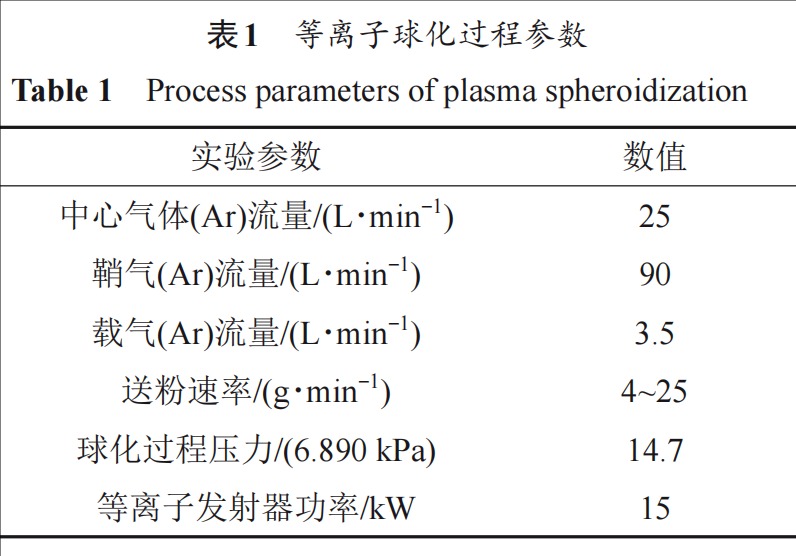
The FS271M3 metal 3D printer of Farsoon was used to perform selective laser melting (SLM) on the tungsten powder and tantalum powder before and after spheroidization, and the SLM process parameters are shown in Table 2.
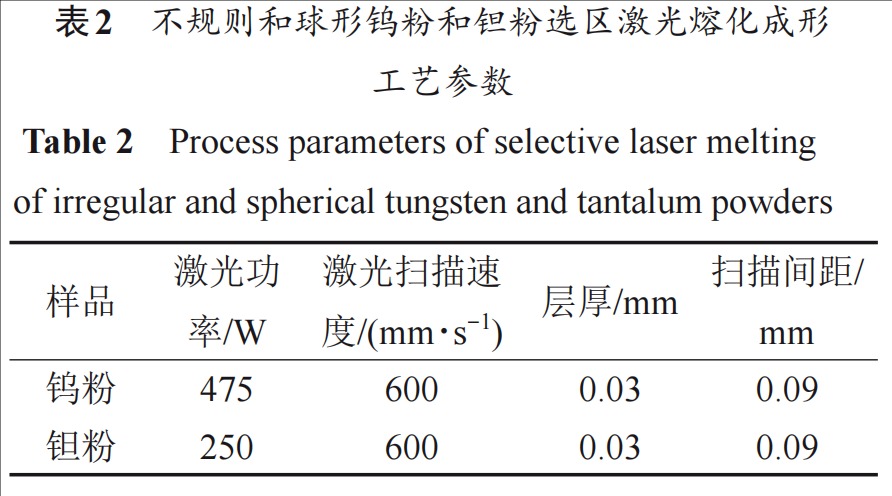
2 Results analysis and discussion
2.1 Effect of powder feeding rate on the morphology of tungsten powder and tantalum powder
Figures 1 and 2 show the SEM images of the original tungsten powder and tantalum powder and the spheroidized tungsten powder and tantalum powder at different powder feeding rates, respectively. Figures 1(a) and 2(a) show the irregular original tungsten powder and original tantalum
powder, respectively, both of which show severe agglomeration and adhesion. It can be seen from Figures 1(b) to 1(f) and 2(b) to 2(f) that the powder feeding rate significantly affects the morphology of the metal powder after spheroidization; when the powder feeding rate of tungsten powder and tantalum powder is greater than 10 g/min, the content of spherical tungsten powder and tantalum powder in the field of view is less, the content of irregular powder is higher, and the agglomeration of powder is more obvious. This is mainly because the powder feeding rate is too fast, and the energy absorbed by a single tungsten powder and tantalum powder particle is not enough to completely melt it. It can be seen from Figures 1(d) and 2(d) that when the powder feeding rate drops to 10 g/min, the spherical tungsten powder and tantalum powder increase, and the powder agglomeration phenomenon is significantly reduced; when the powder feeding rate of tungsten powder and tantalum powder drops to 6 g/min and 8 g/min respectively, most of the tungsten powder and tantalum powder are spheroidized, and the particles are evenly distributed, and the agglomeration phenomenon basically disappears. The spheroidization rate of tungsten powder is calculated using Image-Pro Plus (IPP) software. When the feeding rates of tungsten powder and tantalum powder are 6g/min and 10g/min respectively, the spheroidization rates of tungsten powder and tantalum powder are both over 95%; when the feeding rate of tungsten powder exceeds 6g/min, the spheroidization rate of tungsten powder decreases significantly; when the feeding rate of tungsten powder exceeds 15g/min, the spheroidization rate of tungsten powder is less than 50%. This rule also applies to the spheroidization process of tantalum powder. When the critical feeding rate is exceeded, as the feeding rate increases, the amount of tungsten powder and tantalum powder passing through the plasma area per unit time increases, and the energy required to completely spheroidize the powder particles will also increase. However, the energy that the plasma can provide is a constant under certain experimental conditions and cannot provide more energy. At this time, most of the tungsten powder and tantalum powder particles cannot obtain enough energy in the plasma torch to melt and spheroidize, resulting in a low spheroidization rate. On the contrary, when the powder feeding rate is low, fewer powder particles enter the plasma torch per unit time, and the particles can absorb enough energy to melt into droplets, and spheroidize under the action of surface tension, and finally solidify into spherical powder. In this process, the carrier gas will take away the finer powder particles, and the powder recovery rate will decrease at this time [24]. Therefore, the optimal powder feeding rates for tungsten powder and tantalum powder are 6 g/min and 10 g/min, respectively. In addition, in the SEM images after spheroidization, agglomeration of small spherical powders was observed. The reason may be that during the spheroidization process, spherical droplets that have not yet solidified collide with each other and agglomerate together after solidification. In summary, the greater the powder feeding rate, the smaller the spheroidization rate of tungsten powder and tantalum powder. It can be seen from Figures 1 and 2 that when the feeding rate exceeds the critical value, the spheroidization rate of tungsten powder and tantalum powder decreases rapidly with the increase of the feeding rate. Therefore, controlling the powder feeding rate has a very important influence on the spheroidization effect of tungsten powder and tantalum powder.
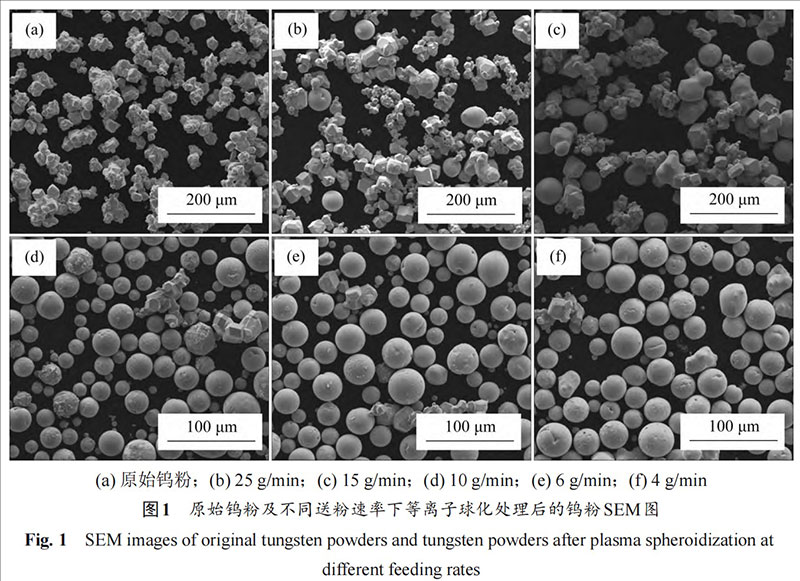
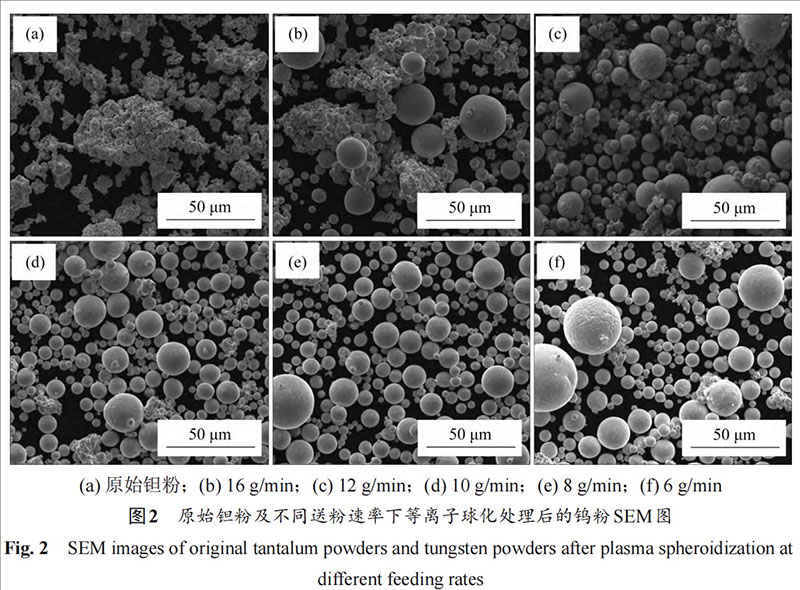
2.2 Effect of powder feeding rate on particle size distribution of tungsten powder and tantalum powder
The particle size of the original tungsten powder and tantalum powder and the tungsten powder and tantalum powder with a spheroidization rate of 95% were measured by a laser particle size analyzer, and the particle size distribution is shown in Figure 3. As can be seen from Figure 3: the particle size distribution of the original tungsten powder and tantalum powder is relatively wide. For the tungsten powder and tantalum powder with a spheroidization rate of 95% (as shown in Table 3), the particle size distribution of the spherical tungsten powder and tantalum powder is relatively narrow. The main reason is that during the spheroidization process, when the powder enters the plasma zone, very little nano-sized original powder is directly melted and vaporized at high temperature, and the rest is also formed into fine particles after cooling, and is collected by the cyclone collector with the working gas, so there are basically no nano-sized particles. When the large particles enter the high-temperature area of the plasma, the particles melt into large droplets. When moving with the working gas, due to their own surface tension and the action of external gas, they cannot maintain their original size. Therefore, they are divided into 2 or more droplets, and then cooled into multiple small spherical particles. In addition, there are still a lot of agglomerated powders in the original powder particles, which are dispersed into smaller spherical particles during the spheroidization process and are evenly dispersed. Therefore, after spheroidization, the average particle size of the overall powder becomes smaller and the particle size distribution becomes more concentrated.
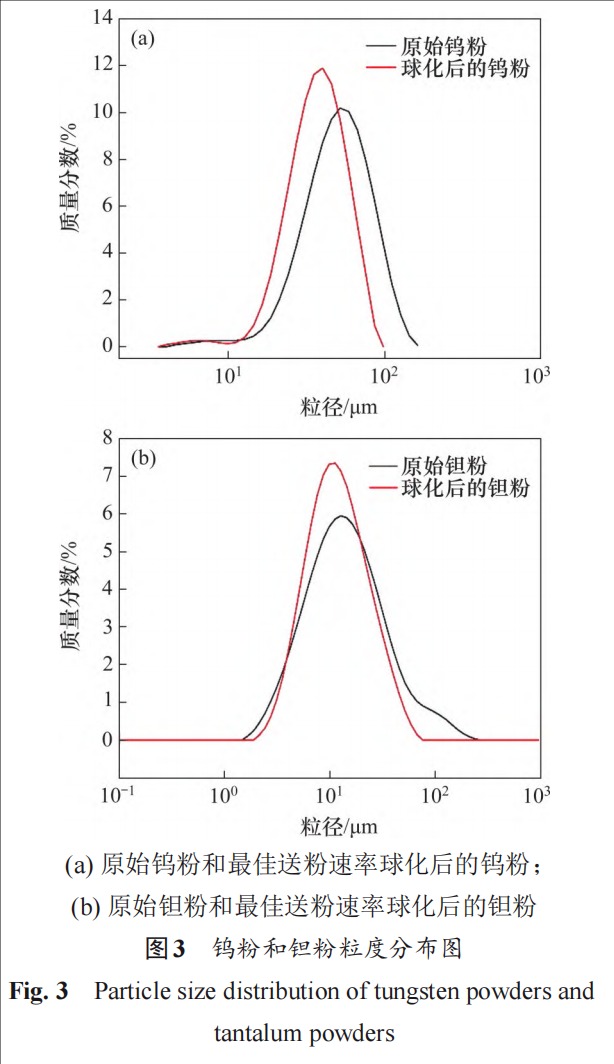
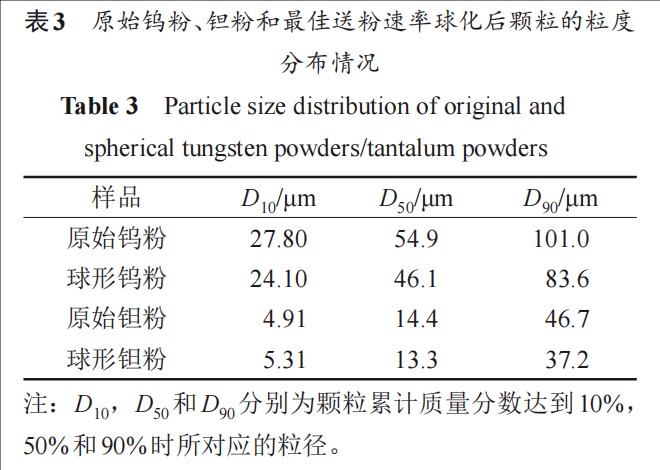
2.3 Effect of spheroidization rate on the fluidity and bulk density of tungsten powder and tantalum powder
In order to study the effect of the spheroidization rate of powder on fluidity and bulk density, the flow rate and bulk density of the original tungsten powder and tantalum powder as well as the tungsten powder and tantalum powder with a spheroidization rate of more than 95% in Figure 2 (hereinafter referred to as spherical tungsten powder) were measured by flow meter. The results are shown in Table 4. It can be seen from Table 4 that after spheroidization, the flow rate and bulk density of the powder are significantly improved. After spheroidization, the morphology of the raw material powder particles changes from an extremely irregular shape to a spherical shape, the contact area between the particles is small, the friction resistance between the particles is reduced, and the particles are densely packed.
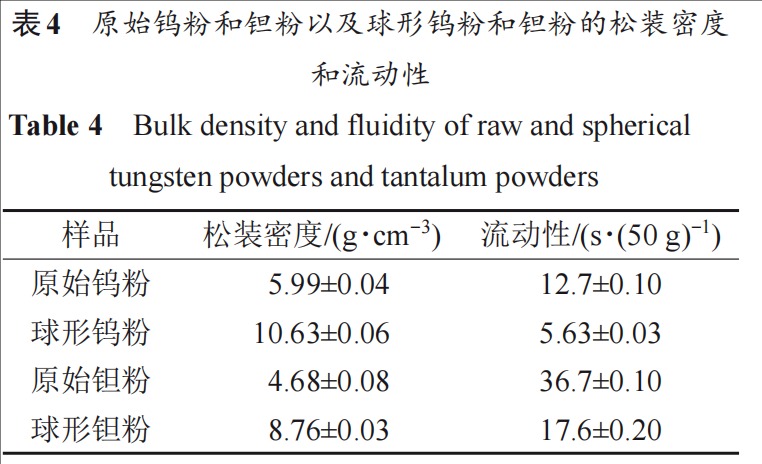
2.4 Effect of spheroidization process on the phase composition of tungsten powder and tantalum powder
Figure 4 shows the XRD graphs of tungsten powder and tantalum powder before and after plasma spheroidization. As shown in Figures 4(a) and 4(b), the diffraction peaks of tungsten powder and tantalum powder after spheroidization are consistent with those of original tungsten powder and tantalum powder, and the diffraction peak positions are (110), (200) and (211), respectively, which are consistent with the standard PDF cards of tungsten and tantalum, and are both body-centered cubic (bcc) structures. Table 5 shows the chemical composition analysis results of the original powder and the powder after spheroidization. Combined with the XRD analysis results, it is verified that there is no oxidation and other impurities involved in the preparation of spherical tungsten powder and tantalum powder.
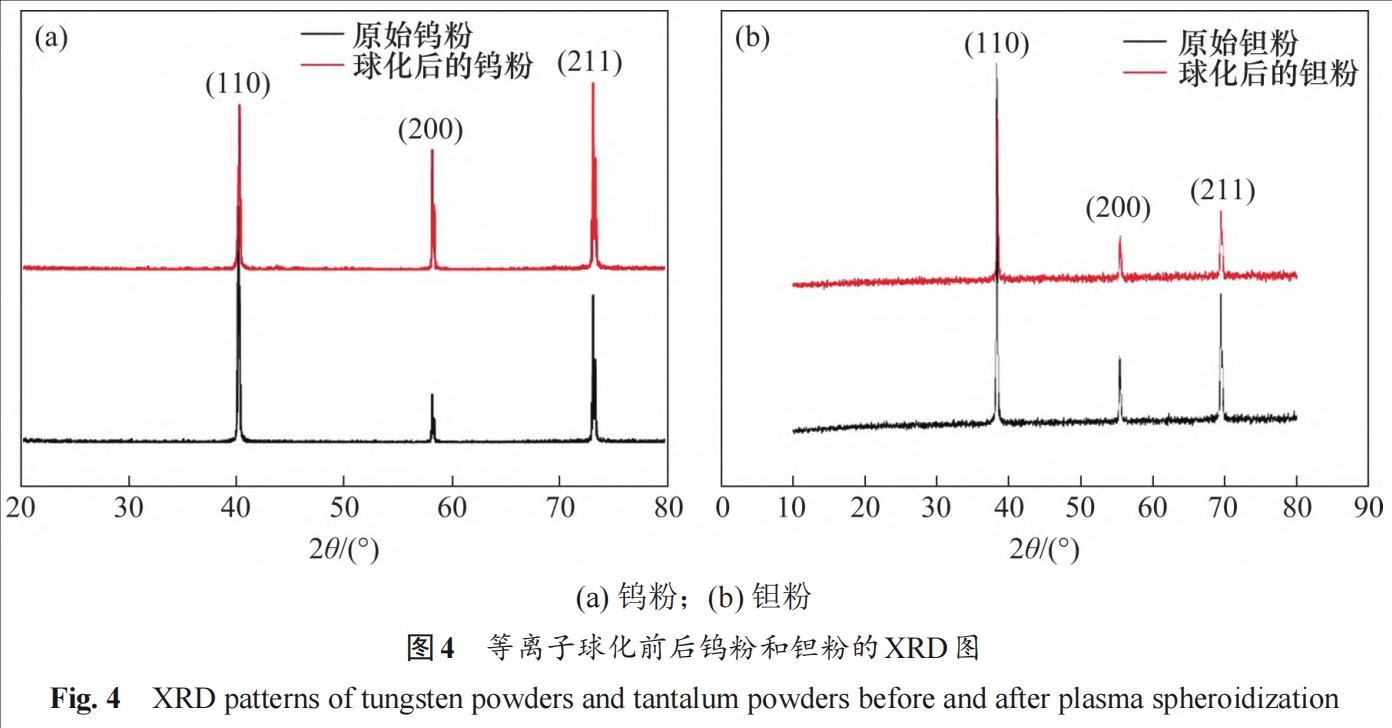
2.5 3D printing verification of spherical tungsten powder and tantalum powder
The original tungsten powder and tantalum powder and tungsten powder and tantalum powder with a spheroidization rate of 95% were used as raw materials, respectively, and the selective laser melting technology (SLM) was used for forming, and the microstructure and density of the printed block were analyzed and characterized.
2.5.1 Figure 5 shows the optical microscopic images of spheroidized tungsten powder, tantalum powder and original tungsten powder and tantalum powder after selective laser melting. It can be seen from Figure 5 that under the same parameters, there are a large number of metallurgical defects such as microcracks and pores on the surface of the samples prepared using raw powder. Figures 5(a) and 5(b) show the positive surface images of the samples obtained by SLM molding of original tungsten powder and tantalum powder, respectively. It can be seen that there are a large number of cracks on the surface, and the crack distribution on the surface of the tungsten block is almost parallel to the laser scanning direction, while the cracks on the surface of the tantalum block are mainly distributed along the grain boundaries. Due to the high temperature and large thermal stress at the contact part of the two lasers during laser scanning, irregular powders may have unmelted parts at the contact part of the laser under laser melting, so crack sources are easily generated. Usually, cracks will extend along the laser scanning direction, so there are a large number of cracks at each laser contact part. However, due to the irregular shape of the original powder and uneven accumulation during the laser scanning process, the molten pool in the center of the laser scanning is unstable. There may be holes and undissolved particles, which cause defects. These defects are prone to crack sources at weakly bonded grain boundaries under the thermal stress caused by rapid cooling. The temperature of the laser molten pool gradually decreases from the center to the sides. Therefore, the cracks will expand from the center of the molten pool to the sides. The cracks will expand and connect multiple molten pools and expand into macro cracks. The reason for the formation of holes is that the original tungsten powder is unevenly piled up during the powder spreading process due to different particle sizes and shapes, and the original tungsten powder particles are large. When scanning the layer morphology, the tungsten powder is unevenly piled up during the powder spreading process, and the particles are not melted, resulting in the formation of holes. Figures 5(b) and 5(d) show the metallographic images of the positive surfaces of the samples prepared from spherical tungsten powder and tantalum powder, respectively. It can be seen that the samples formed by selective laser melting with spherical tungsten powder and tantalum powder as raw materials have fewer pores on the surface, only a few small pores, and the cracks basically disappear. In the process of laser forming of spherical powder, due to the small gaps in the powder accumulation and the uniform powder spreading, there are basically no unmelted particles during the laser scanning process, and fewer defects are generated.
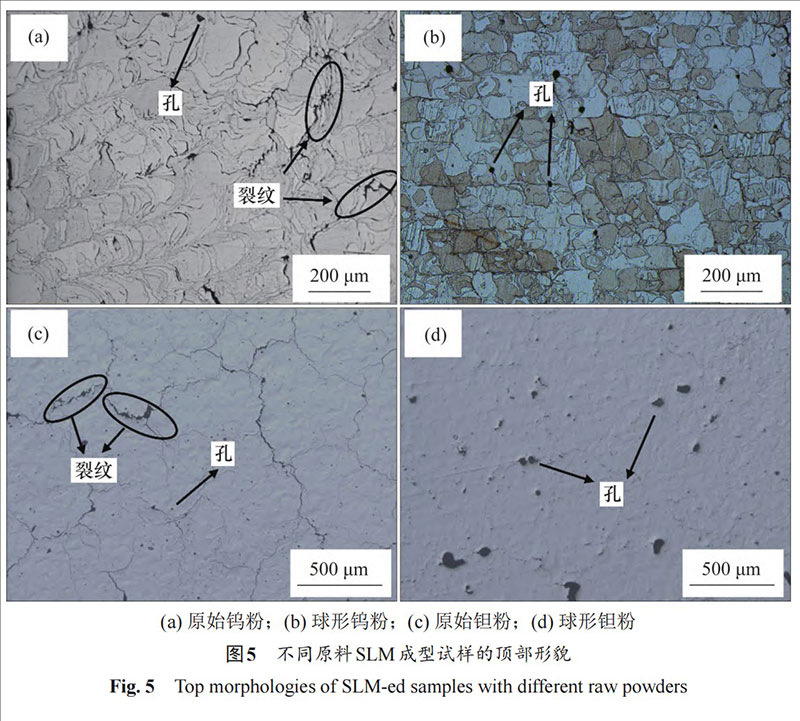
2.5.2 Density of tungsten/tantalum formed by selective laser melting (SLM) The density of bulk tungsten and bulk tantalum formed by SLM before and after spheroidization was measured, and then the actual density obtained by the measurement was divided by the theoretical density to obtain the density of bulk tungsten and bulk tantalum as shown in Table 6. It can be seen from Table 6 that the density of the tungsten block and tantalum block after spheroidization is significantly higher than that of the block before spheroidization.
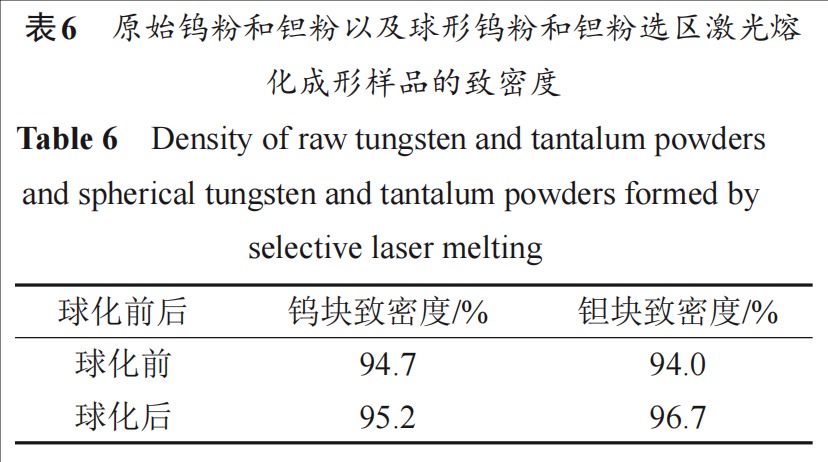
3 Conclusion
1) The higher the powder feeding rate of tungsten powder and tantalum powder raw materials, the shorter the time that tungsten powder and tantalum powder particles stay in the plasma torch, resulting in a decrease in the spheroidization rate. When the powder feeding rates of tungsten powder and tantalum powder exceed 6 g/min and 10 g/min, respectively, the spheroidization rate of the powder decreases sharply with the increase of the powder feeding rate.
2) As the spheroidization rate of tungsten powder and tantalum powder increases, the fluidity of tungsten powder and tantalum powder becomes better, and the bulk density gradually increases. XRD detection and composition analysis of spheroidized tungsten powder and tantalum powder showed that neither of them was oxidized and no other impurities were involved.
3) When the original tungsten powder and tantalum powder and spherical tungsten powder and tantalum powder are formed by SLM, the density of the spheroidized powder formed samples is improved under the same parameters.
Spherical tungsten, spherical tantalum powder-Stardust Technology
About Stardust Technology
Stardust Technology (Guangdong) Co., Ltd. is a national high-tech enterprise specializing in the research, development, production and sales of high-end spherical powder materials for 3D printing, powder metallurgy, surface engineering and other fields. The company insists on taking radio frequency plasma spheroidization powder making technology as the core and providing internationally advanced powder products and application solutions.
The company's main products include high-end rare refractory metals such as tungsten, molybdenum, tantalum, niobium, vanadium, rhenium, chromium and their alloys, compound spherical powders, and also provides technical services such as radio frequency plasma spheroidization, plasma rotating electrode atomization, 3D printing, hot isostatic pressing, injection molding, powder metallurgy, etc.
The spherical tungsten powder and spherical tantalum powder produced by Stardust Technology using radio frequency plasma spheroidization technology have the characteristics of high purity and low oxygen, high sphericity, controllable particle size distribution, excellent fluidity, stable quality, no satellite balls, and very few hollow particles. They are suitable for 3D printing, hot isostatic pressing, laser cladding and other processes.
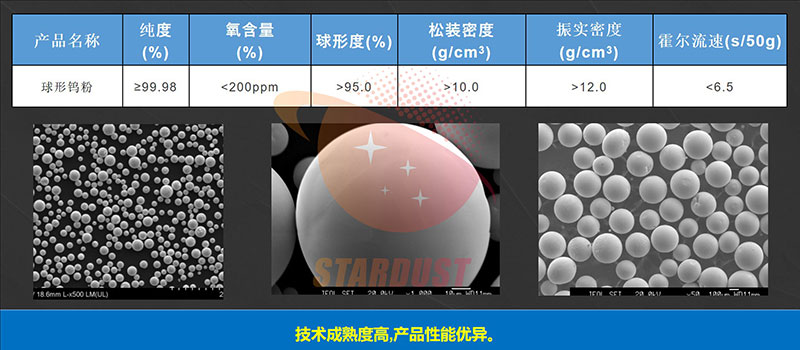
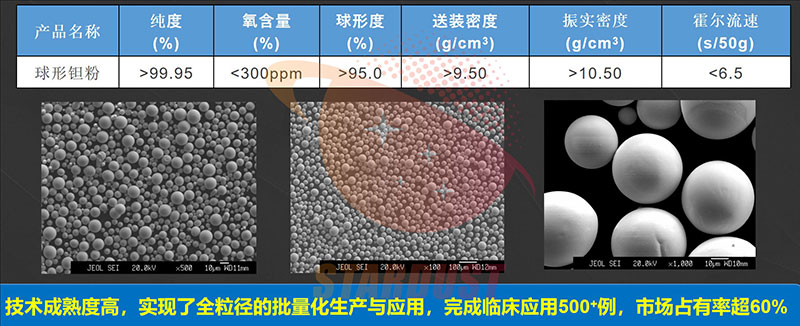
For more details, please contact us
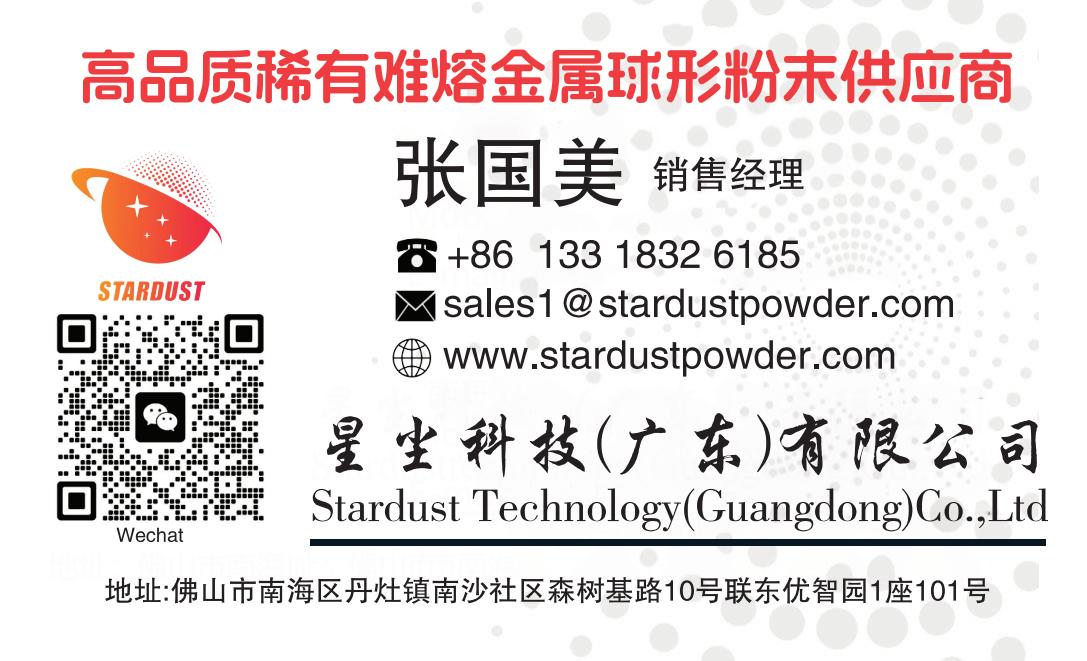

Paper citation information:Zhang Taomei, Zi Xuhui, Cheng Xiaofan, Chen Chao, Zhou Kechao. Research on plasma spheroidization process of spherical tungsten and tantalum powders for 3D printing[J]. Journal of Central South University (Science and Technology), 2022,53(7): 2439−2446.DOI: 10.11817/j.issn.1672-7207.2022.07.004